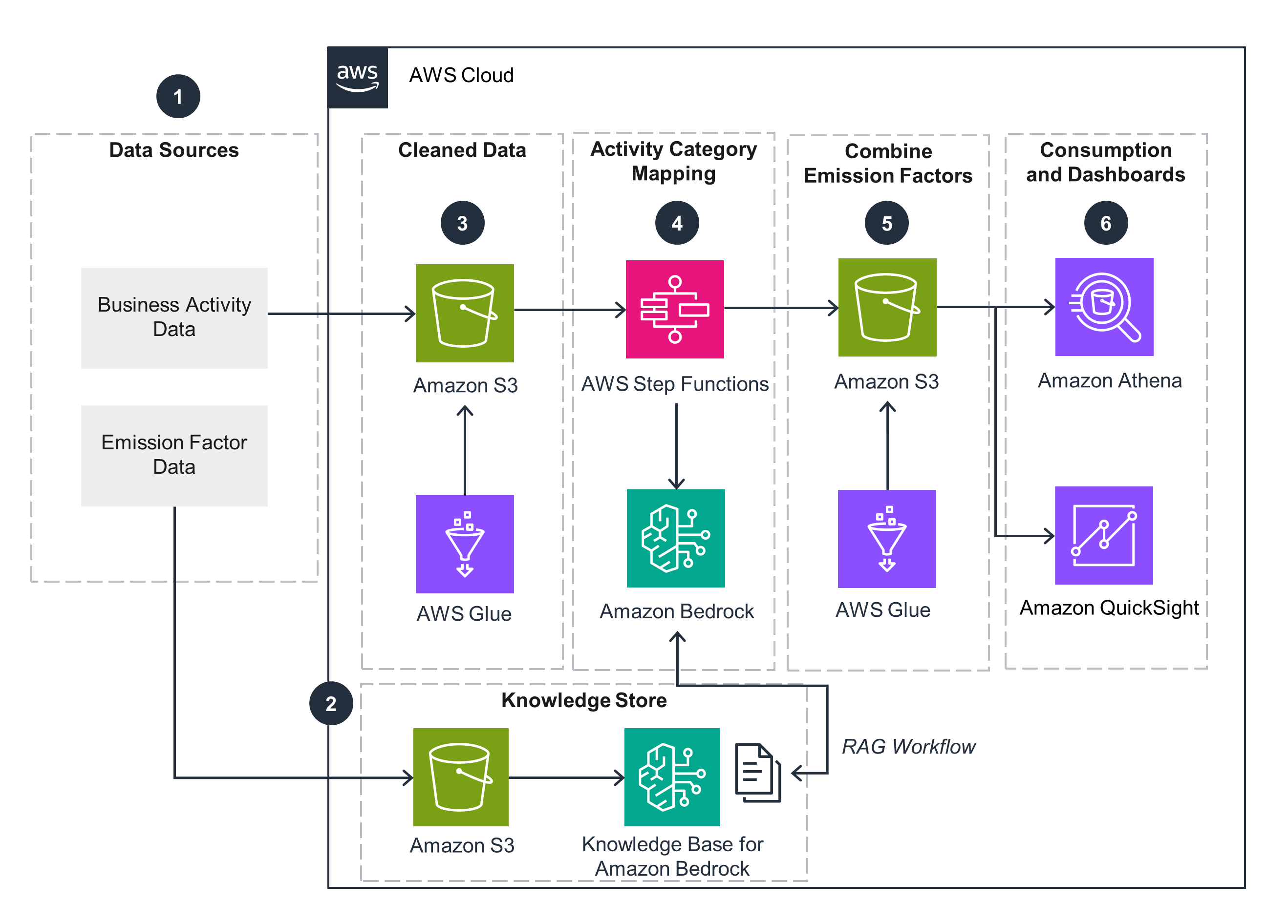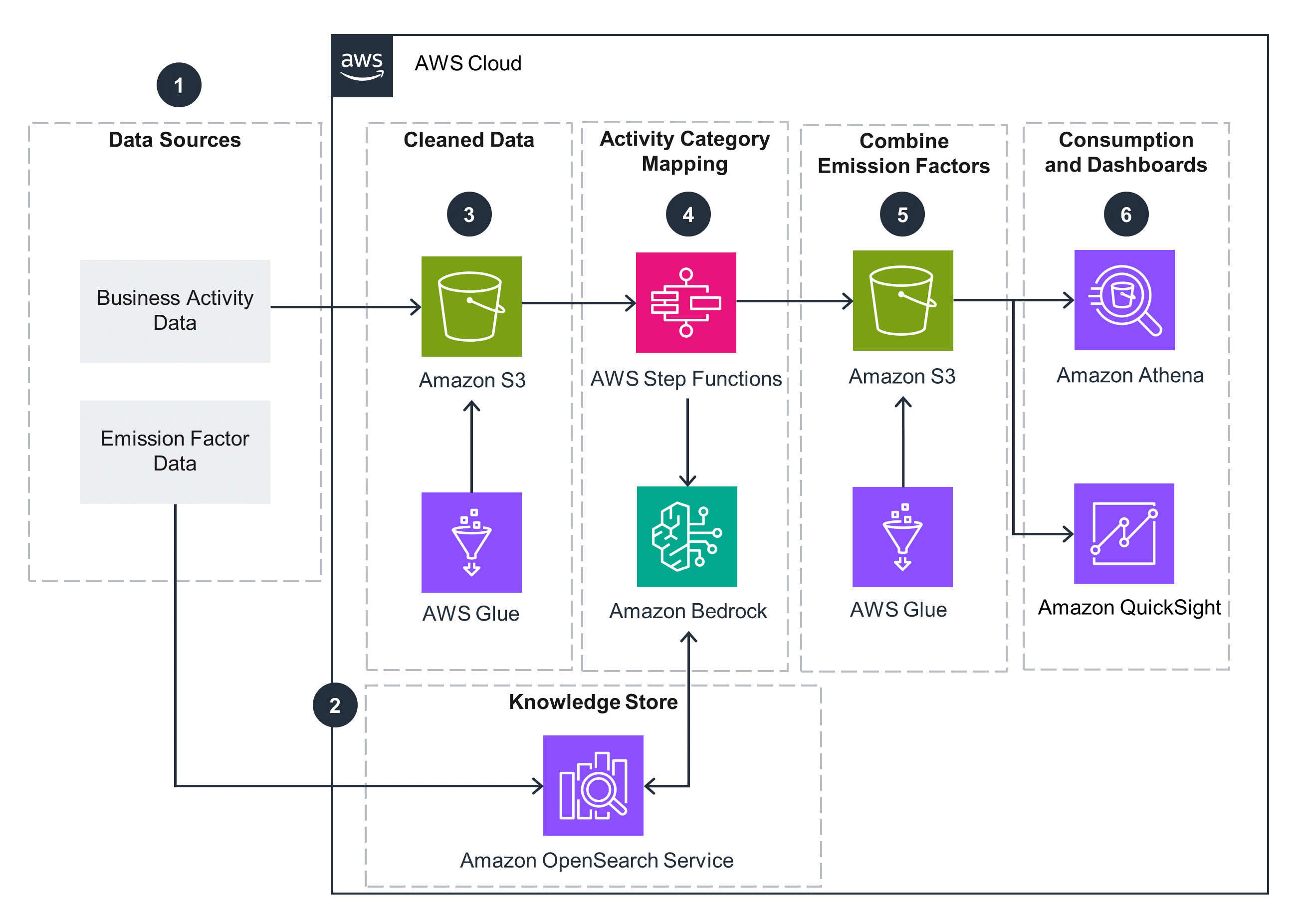- AWS Solutions Library›
- Guidance for Environmental Impact Factor Mapping on AWS
Guidance for Environmental Impact Factor Mapping on AWS
Overview
This Guidance automates the selection of environmental impact factors (EIFs)—sometimes also referred to as emission factors—using foundation models with retrieval augmented generation (RAG) to scale product carbon footprint assessments. EIFs measure activities into metrics to assess potential environmental impacts, like carbon dioxide equivalent (CO2e). The Guidance takes in activity data descriptions (such as purchase orders) and parameters (such as regions), and returns a ranked list of EIFs with similarity scores. Human annotators, invoked by low similarity scores or random sampling, provide ongoing evaluation, improvement, and corrective annotations.
The Guidance is based on using two algorithms published by Amazon: CaML, an algorithm to automate Economic Input-Output based Life Cycle Assessment (EIOLCA) using semantic text similarity matching and Flamingo, an algorithm for automatically identifies process-based LCA EIFs.
How it works
Option 1
This architecture diagram shows how to scale carbon footprint assessments using a knowledge store made up of Amazon S3 and Amazon Bedrock. For Option 2, open the other tab.

Option 2
This architecture diagram shows how to scale carbon footprint assessments using a knowledge store made up of Amazon OpenSearch Service Neural Search. For Option 1, open the other tab.

Get Started
Deploy this Guidance
Sample code
Well-Architected Pillars
The architecture diagram above is an example of a Solution created with Well-Architected best practices in mind. To be fully Well-Architected, you should follow as many Well-Architected best practices as possible.
Amazon CloudWatch provides centralized logging with metrics and alarms across all deployed services to raise alerts for operational anomalies.
Resources are protected using AWS Identity and Access Management (IAM) policies and principles. Use least-privilege access and role-based access to grant permissions to operators. Data at rest is encrypted using AWS Key Management Service (KMS). HTTPS endpoints with transport layer security (TLS) provide encryption in transit for service endpoints.
These serverless services automatically adapt to demand changes. Amazon S3 is fully elastic, growing and shrinking as data is added or removed, providing durable cloud storage and industry-leading availability without overprovisioning. Step Functions offers serverless orchestration with built-in error handling for modern applications. As the application runs, it maintains state, tracks workflow steps, and stores an event log passed between components. If networks fail or components hang, the application can resume from the last checkpoint, ensuring a seamless workflow.
Amazon Bedrock allows developers to choose suitable foundation models from leading AI companies for their use cases. Amazon Bedrock is a fully managed service offering high-performing foundation models through a single API, along with capabilities for building secure, private, and responsible generative AI applications.
AWS Glue enables quick data discovery and preparation for analytics, ML, and application development. AWS Glue is a serverless data integration service, eliminating infrastructure management through automatic provisioning and supporting various data processing frameworks and workloads.
This Guidance relies on serverless services such as Amazon S3, Athena, and AWS Glue. These services require no infrastructure setup or management and scale automatically to match demand, ensuring minimum resource utilization. Serverless scaling helps reduce overall resource usage and costs by adjusting to fluctuating demands.
Step Functions call Amazon Bedrock directly, eliminating the need for dedicated compute to process data. This approach reduces compute usage and, as a result, lowers carbon footprint.
Disclaimer
The sample code; software libraries; command line tools; proofs of concept; templates; or other related technology (including any of the foregoing that are provided by our personnel) is provided to you as AWS Content under the AWS Customer Agreement, or the relevant written agreement between you and AWS (whichever applies). You should not use this AWS Content in your production accounts, or on production or other critical data. You are responsible for testing, securing, and optimizing the AWS Content, such as sample code, as appropriate for production grade use based on your specific quality control practices and standards. Deploying AWS Content may incur AWS charges for creating or using AWS chargeable resources, such as running Amazon EC2 instances or using Amazon S3 storage.
While this Guidance serves as a starting point to help streamline EIF mapping for Life Cycle Assessment (LCA) experts, the results should be vetted by LCA experts prior to considering specific actions. The user should also supplement the results with appropriate information for greater accuracy. This Guidance uses v1.2 USEEIO database as a sample for demonstration purposes only. We recommend that the users apply the most recent version of the database.
The model was tested on products in the US retail sector and does not cover services. The user assumes responsibility to ensure accuracy of the emission factor mapping and to validate the results. Using this Guidance does not guarantee verified greenhouse gas (GHG) disclosures. AWS does not assume any legal liability or responsibility for any errors or omissions or for the results obtained from the use of this Guidance.
Did you find what you were looking for today?
Let us know so we can improve the quality of the content on our pages